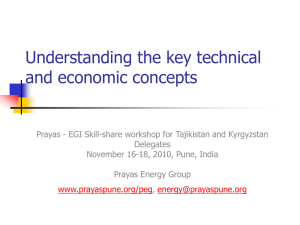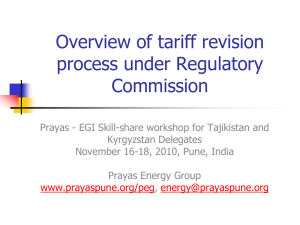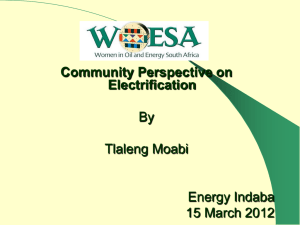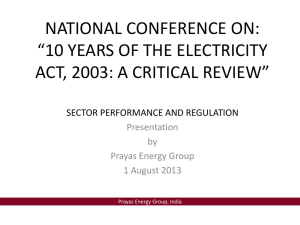Overview of Indian Power sector
advertisement
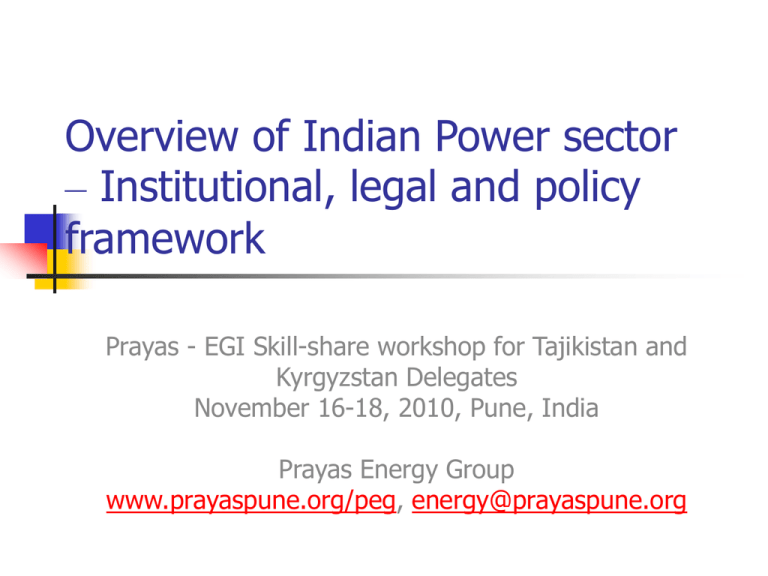
Overview of Indian Power sector – Institutional, legal and policy framework Prayas - EGI Skill-share workshop for Tajikistan and Kyrgyzstan Delegates November 16-18, 2010, Pune, India Prayas Energy Group www.prayaspune.org/peg, energy@prayaspune.org Reform Status Implemented Partially Implemented Reg.Commn, Unbundling (most states) Not Implemented Full Cost Recovery Distbn-Privatisation (Orissa (99),Delhi (02), Urban Franchisee - Bhivandi(07), Nagpur (08), MP, Agra-Kanpur (09), Gujarat, Rajasthan (in progress) Slow increase in private gen & distrbn, Technocratisation of decision making, Commercial/Efficiency focus, Evolving Electricity market - Trading, Power exchange Prayas - EGI workshop Pune 2010 2 Schematic of institutional and policy structure P U Executive Policies MoP Regulations & Orders Tariff B L E. CERC Capacity Addition I Legislature Act SERCs C Consumer Service Prayas - EGI workshop Pune 2010 3 Institutional framework -1 Central Government State Government Ministry of Power, Ministry -Ministry of Energy, State of New & Renewable Renewable Energy Agency Energy -Corporations: Generation, - Planning Commission, Transmission, Distribution Central Electricity Authority, -State Load Dispatch Centre Bureau of Energy Efficiency -State Regulatory -Corporations: Generation, Commission Transmission, Trading, Financing, Manufacturing -National and Regional Load Dispatch -Appellate Tribunal for Electricity and Central Electricity Regulatory Commission - Private sector – Indian and International Generation, Transmission, Distribution, Trading, Financing, Manufacturing, Services Prayas - EGI workshop Pune 2010 4 Institutional framework -2 Ministry of Power Central Electricity Authority Legal provisions (Electricity Act 2003), Policy directions such as National Electricity and Tariff Policy, Guidelines for competitive bidding, etc National Electricity plan, monitoring of projects, maintaining data and statistics, demand forecast, feasibility analysis of Hydro projects, etc Generation company Subject to provisions of act, can generate power based on contracts or independently. Needs to abide by Load Dispatch directions for scheduling its generation Transmission Company Builds and operates the transmission network and infrastructure Distribution company Load Dispatch Regulatory Commission Distributes electricity to consumers, in charge of maintaining and building distribution network, metering, billing and collection from consumers Statutory autonomous body entrusted with scheduling and accounting of power at state level. Responsible for maintaining grid stability and discipline Regulates all players in the sector, decides tariff, approves capital expenditure, monitors supply and service quality and ensure implementation of various provisions of Electricity Act 2003 Prayas - EGI workshop Pune 2010 5 Institutional Framework -3 Generation: Public, Private Regulator Distribution: Public, Private, Bulk consumers Transmission: Public, Private Power Flow Market Money Flow Regulation Prayas - EGI workshop Pune 2010 6 Legal & Policy Framework: Electricity Act 2003 A Central Act Old national Acts repealed Indian electricity Act 1910 Electricity (supply) Act 1948 Electricity Regulatory Commissions Act 1998 State reform Act provisions to be valid provided they are not inconsistent with the Electricity Act 2003 Hence, the entire Indian electricity sector will be governed by the Electricity Act 2003 Prayas - EGI workshop Pune 2010 7 Electricity Act 2003 Emphasis on Breaking monopoly of State Electricity Boards and promoting competition / trading Creating economic imperative for fundamental changes Attracting new investment Reduction of cross-subsidy Competition for increasing efficiency (mostly in generation) Defines institutional and policy workshop Pune 2010 country frameworkPrayas for- EGIthe whole 8 8 Electricity Act 2003 - Key provisions De-license Generation Open Access in Transmission, Distribution Promote trading and markets De-license rural distribution Establishes norms for transparency and public participation Re-defined role and mandate of State Governments, Regulators and Licensees Establishment of Consumer Grievance Redressal Forums Prayas - EGI workshop Pune 2010 9 National Polices & Programs National Electricity Policy - February 2005 Tariff Policy- Jan 06 (Amendment – Mar 2008) National Rural Electrification Policy - Aug 2006 National Electricity Plan - Aug 2007 National Programs Rural Electrification: RGGVY Apr 2005 Urban Distribution: R-APDRP July 2008 Prayas - EGI workshop Pune 2010 10 National Electricity Policy -1 Emphasises the electricity – development link: “Electricity is an essential requirement for all facets of our life. It has been recognized as a basic human need. It is a critical infrastructure on which the socio-economic development of the country depends” Issues addressed: Rural Electrification Generation , Transmission, Distribution Recovery of Cost of services & Targeted Subsidies. Technology Development and Research and Development (R&D) Competition aimed at Consumer Benefits Financing Power Sector Programmes Including Private Sector Participation. Energy Conservation , Environmental Issues Training and Human Resource Development Cogeneration and Non-Conventional Energy Sources Protection of Consumer interests and Quality Standards Prayas - EGI workshop Pune 2010 11 National Electricity Policy -2 Generation Power-Demand to be fully met by 2012 A part of new generating capacity (say 15%) may be sold outside long term Power Purchase Agreements (PPAs) Transmission & Distribution Development of National Grid National and State level Open access to be facilitated Demand side management Prayas - EGI workshop Pune 2010 12 National Electricity Policy - 3 Consumers Access to electricity for all households by 2010 Per capita availability of electricity to be increased to over 1000 units by 2012 Minimum lifeline consumption of 1 unit/household/day as a merit good by year 2012 Cross subsidies to be reduced gradually Provision of support to lifeline consumers (households below poverty line having consumption of 30 units per month) with tariff being at least 50% of average cost of supply. Grievance Forum and Ombudsman to be set up Government and RCs to facilitate capacity building of consumer groups. Prayas - EGI workshop Pune 2010 13 Tariff Policy -1 Objectives Ensure availability of electricity to consumers at reasonable and competitive rates Ensure financial viability of the sector and attract investments; Promote transparency, consistency and predictability in regulatory approaches across jurisdictions and minimise perceptions of regulatory risks; Promote competition, efficiency in operations and improvement in quality of supply Covers General approach to tariff Generation, Transmission, Distribution Tariff Trade margin Prayas - EGI workshop Pune 2010 14 Tariff Policy -2 Power purchase by DISCOMS to be based on competitive bidding (exception for public sector) Cross subsidy surcharge is to be paid by open access consumers. This is calculated as the difference between the consumer tariff and the cost of supply Poor consumers (consuming say less than 30 units/month) will get support through cross subsidy. Their tariff will be at least 50% the average cost of supply. SERCs will notify a roadmap to reduce cross subsidy so that by 2011, tariffs would be within +/20% the average cost of supply Amendment (Mar 08) on Hydro tariff (transparent bidding, long term PPA for 60%, R&R, development fund etc Prayas - EGI workshop Pune 2010 15 National Rural Electrification Policy-1 Goals Provision of access to electricity to all households by year 2009 Quality and reliable power supply at reasonable rates Minimum lifeline consumption of 1 unit per household per day as a merit good by year 2012. Covers Approach to rural electrification; RGGVY program; Definition of electrified village; Involvement of local community; Financial assistance, Standalone systems, Bulk power purchase & management of rural distribution Prayas - EGI workshop Pune 2010 16 National Rural Electrification Policy -2 Grid and off grid solutions for Household electrification and economic activities Rural Electrification Corporation to be the nodal agency, Central support to States for RE States to prepare RE Plan, set up District Committees, notify rural areas . SERCs to monitor Franchisees for rural distribution Prayas - EGI workshop Pune 2010 17 National Programs Rural Electrification: Rajiv Gandhi Grameen Vidyutikaran Yojana (RGGVY) 2005 Village (1,25,000) and rural household (78 million) electrification Central government to provide financial and implementation support to States Guarantee by States for minimum 6-8 hours of power supply Decentralised Distributed Generation (DDG) to supplement grid power US$ 12,500 m outlay Urban Distribution: Re-structured Accelerated Power Development and Reforms Programme (R-APDRP) 2008 Focus on base line data creation and distribution loss reduction (urban) US$ 2500 m for base line data and IT applications US$ 10,000 m for distribution strengthening Prayas - EGI workshop Pune 2010 18 Schematic of institutional and policy structure TAP P U Executive Policies MoP Regulations & Orders Tariff B L CERC E. Capacity Addition I Legislature Act SERCs C Consumer Service TAP Prayas - EGI workshop Pune 2010 19 Players and Interactions Consumers/Public Contract Utility Regulatory Commissions Political Voice Authority / policy Government / Policy makers Prayas - EGI workshop Pune 2010 20 Discussion Multiple institutions, with different roles and mandates Evolving legal and policy framework Different drivers and different interests influencing processes and decisions Challenges of Civil Society Groups to find their feet and push for public interest At different levels, different times, with different actors Prayas - EGI workshop Pune 2010 21
